Invertebrates in the Plankton: Cnidaria &
Ctenophora
Cnidaria
Hydrozoa are a class of jellyfish in the Phylum Cnidaria.
Many of them show a phenomenon known as an alternating life cycle, which
includes a benthic stalked (polyp) form, and free-swimming jellyfish (medusa)
form. The polyps may be found attached to docks or floats, while the medusae
live in the plankton. The medusa is the reproductive stage--an individual
has either male or female gonads. Fertilization takes place in the water
column. The fertilized egg develops as a planktonic planula larva,
until it settles on a suitable substrate and buds to form a new colony.
This colony of polyps will then bud medusae, continuing the life cycle.
The medusae feed using tentacles to bring prey to the mouth. The tentacles
contain nematocysts, or cells that sting the prey and are also used
for protection. Medusae swim via jet propulsion (pulsing of the bell).
|
Phialidium
is an example of a hydroid medusa.
|
This hydroid
will form a planula larva.
|
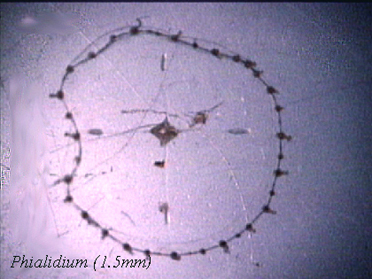
|
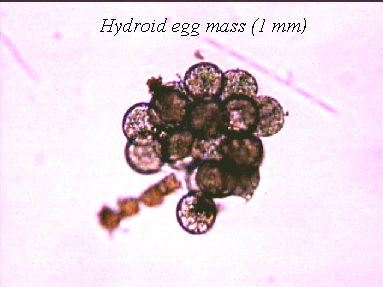
|
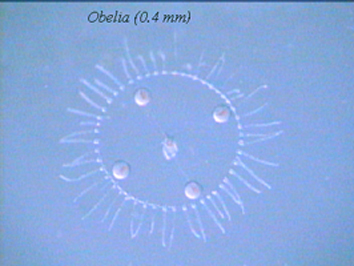
|
Seen here is a picture of the medusa stage in the Obelia
life cycle. This organism shows statocysts, sensory structures that are
used to detect gravity and thereby maintain vertical orientation. Each
Obelia has either male or female gonads and the eggs are internally
fertilized. |
| Sarsia has
a lifestyle similar to Obelia, but some species have both asexual
and sexual reproduction in the medusa stage. During the asexual stage medusae
bud off of the manubrium, the elongated structure surrounding the
mouth. The medusa stage is also morphologically distinct from other species
in that it only has four tentacles and no statocysts. |
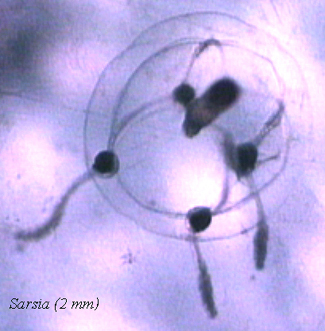 |
| Muggiaea is a
type of cnidarian called a Siphonophore. Siphonophores are floating or swimming
colonies of gelatinous zooids (organisms) that function together. Each individual
in the colony performs a different activity and is given a name that defines
its role. For example, Muggiaea has one angular nectophore, or
bell, which moves the colony by pulsating. The stem of the colony is composed
of gastrozooids, or polyps used in feeding, gonozooids are
involved in reproduction, and dactylozooids are covered in nematocysts
and used for protection. The colony stays buoyant by a drop of oil at the
tip of the bell. The swimming bell moves by shooting forward and veering
in an arc, which drags the stem and other zooids along with it. This
type of movement creates a fishing net used to capture prey. Siphonophores,
along with some other medusa forms and some ctenophores, produce bioluminescence
when they move. |
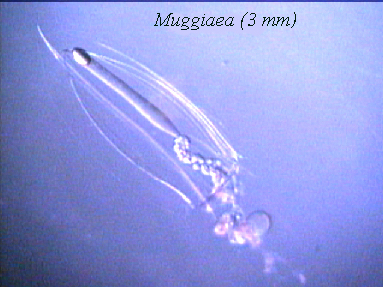 |
| Aglantha does
not have a true polyp stage and it reproduces sexually with gonads hanging
down from the top of the bell. This jelly differs from others in that it
does not move by rhythmic pulses, but it drifts in the water and then leaps
a few centimeters. |
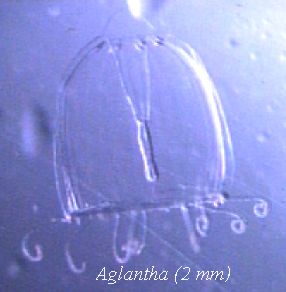 |
Ctenophora
Ctenophores are planktonic
organisms that are jelly-like in form but, unlike true jellies, they propel
themselves by beating rows of compound cilia in waves. Their movement
is therefore very gentle and gradual. The compound cilia occur in
comb rows, five longitudinal rows on the body. Almost all ctenophores are
hermaphroditic. They release their eggs and sperm into the water to be
fertilized. However, there are exceptions. Some species self-fertilize,
while others do not release their eggs until they are fertilized. The two
ctenophores presented here have different methods of feeding.
| Pleurobranchia
have long tentacles lined by colloblasts, or sticky cells, that grab onto
prey when contacted. In a rocking motion, they use tentacles to bring prey
to their mouths. |
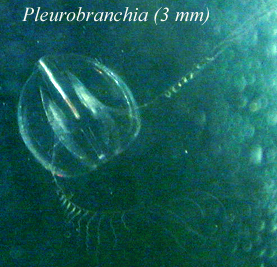 |
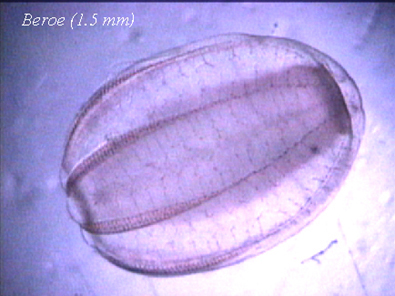 |
In contrast, Beroe
do not have tentacles, so they engulf prey directly into their mouths.
They are able to eat organisms that are larger than themselves (e.g. Pleurobranchia)
because of their large mouth and pharynx. The lips of the animal
have a remarkable ability to seal up, like a ziploc bag, after capturing
prey. |
Plankton
Home Annelida
Arthropoda
Chaetognatha
Chordata
Echinodermata
Mollusca Invertebrates
2000









